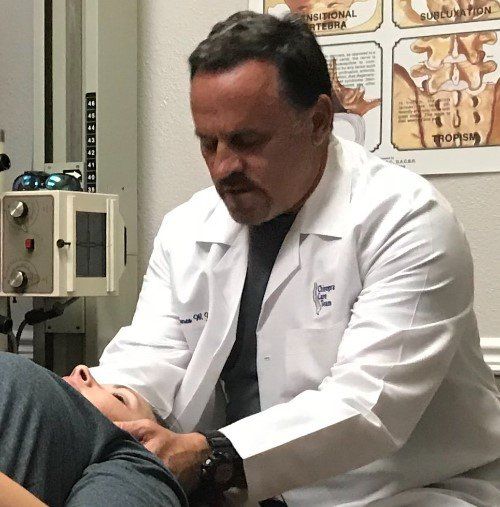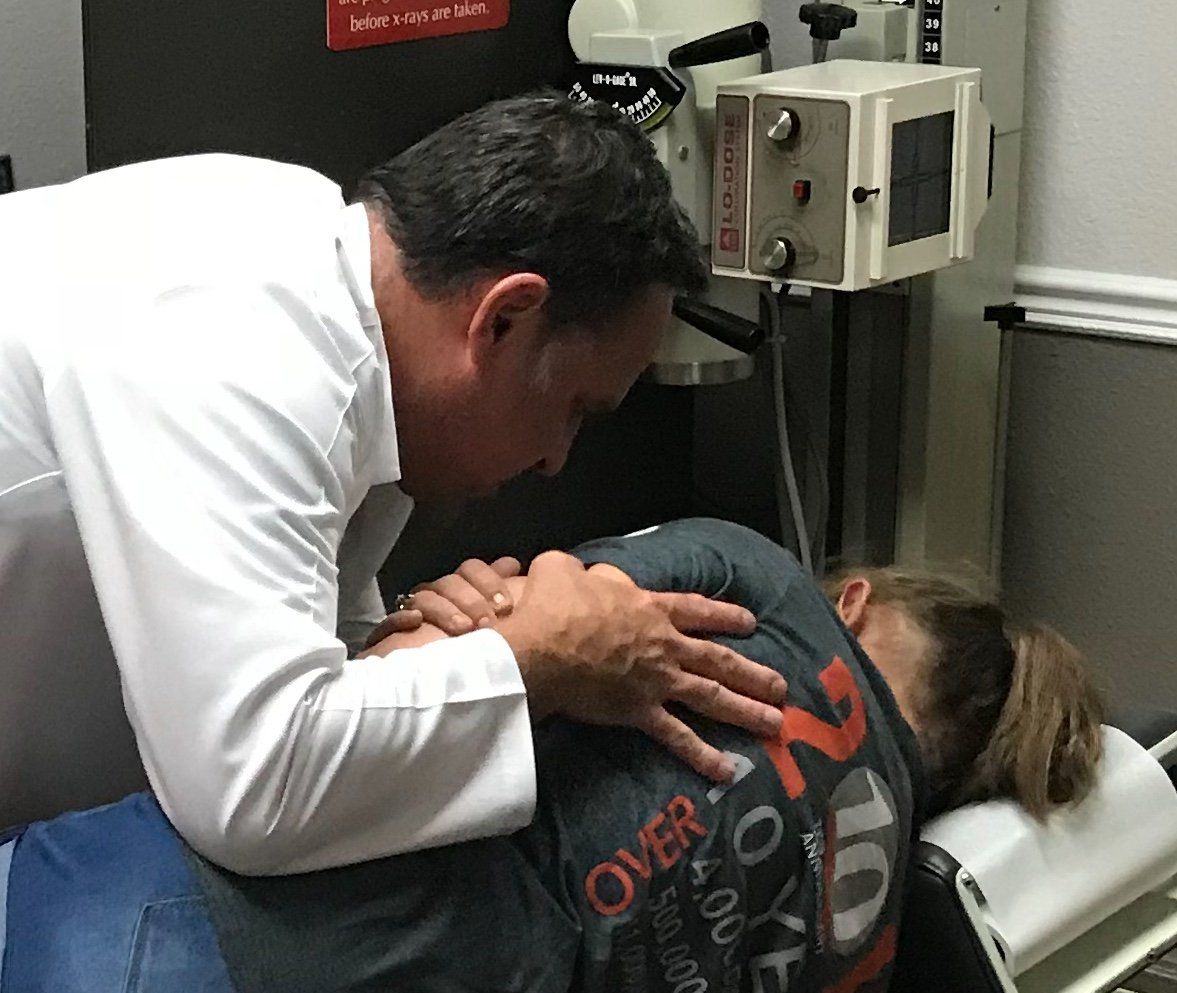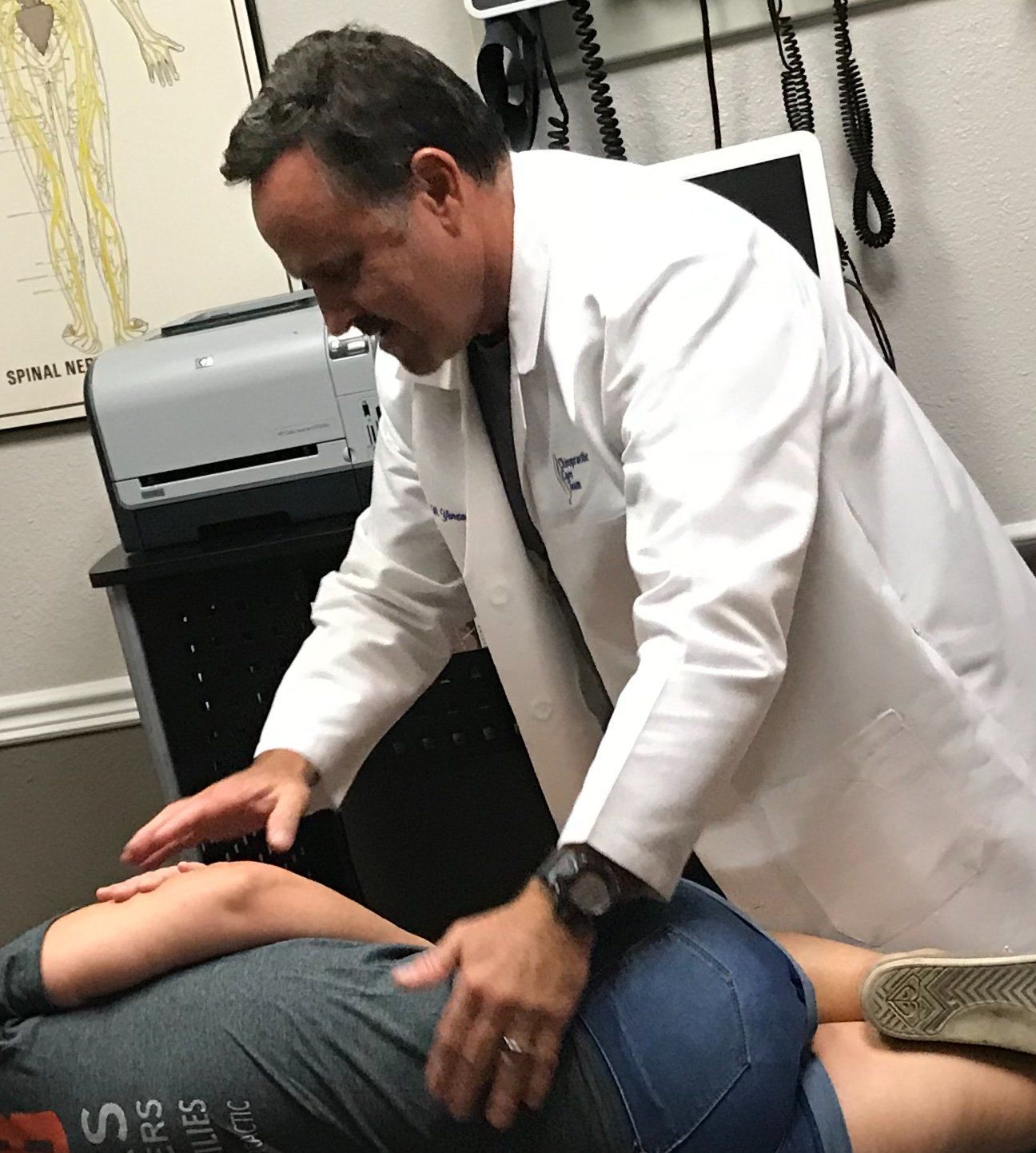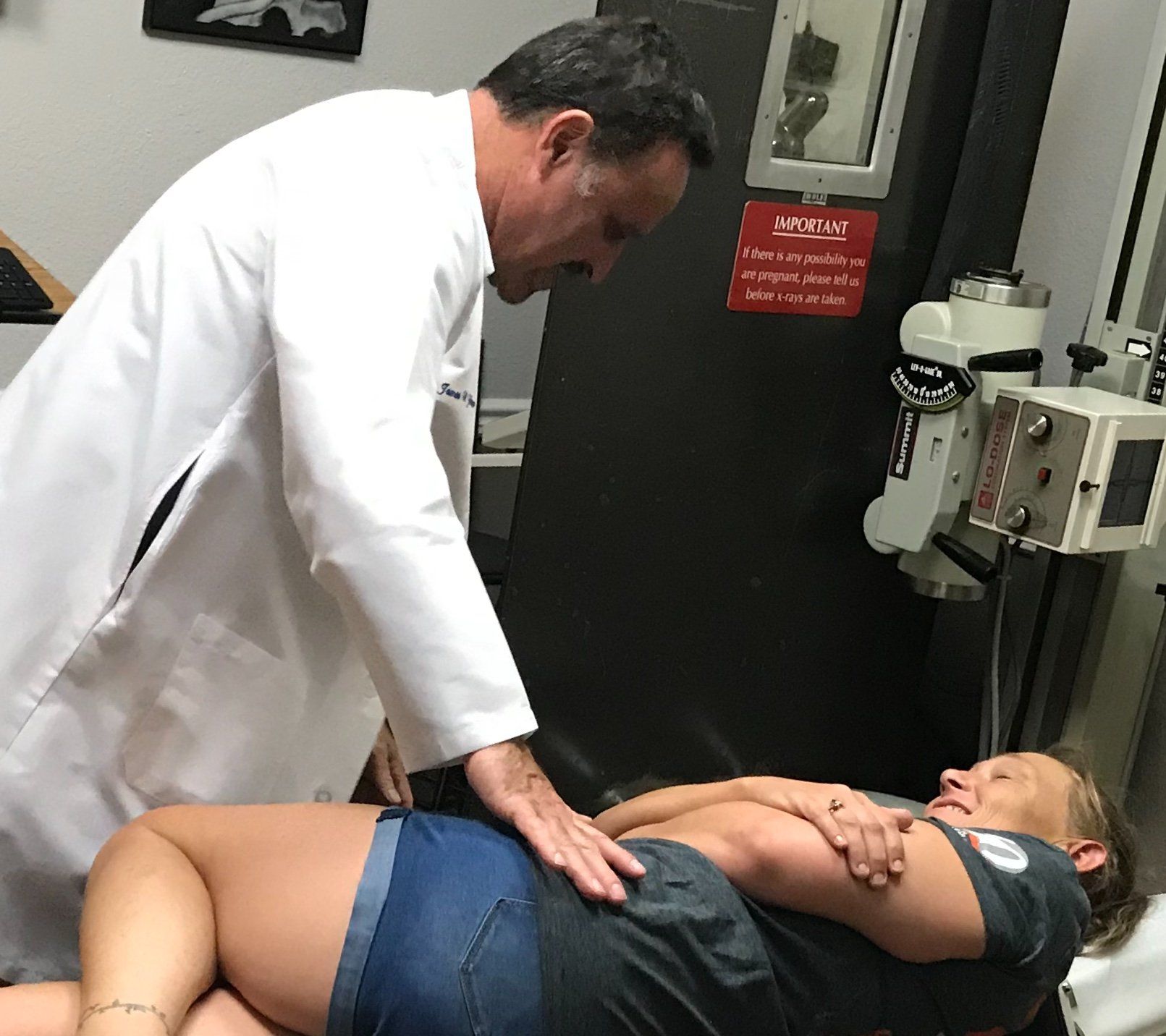The Research and Resources
Developed in 1895 by D.D. Palmer, chiropractic first proved its health benefits when Harvey Lillard came to Palmer with deafness in one ear. Dr. Palmer realized a vertebra was out of place. Palmer adjusted Harvey Lillard and found that Lillard’s hearing was restored. At the same time, Palmer had a patient with a heart problem and noted the following:
“I had a case of heart trouble which was not improving. I examined the spine and found a displaced vertebra pressing against the nerves, which innervate the heart. I adjusted the vertebra and gave immediate relief — nothing “accidental” or “crude” about this. Then I began to reason if two diseases, so dissimilar as deafness and heart trouble, came from impingement, a pressure on nerves, were not other disease due to a similar cause? Thus the science (knowledge) and art (adjusting) of Chiropractic were formed at that time.”
Dr. James W. Yenzer has over 30 years of chiropractic experience and training, He stays current on the newest breakthroughs in chiropractic care, in order to insure the use of the most advanced and efficient practices and techniques. These new methods are safer, more comfortable, and more effective than ever before. This translates to best possible treatment for you. Below we list a few of the researched benefits of Chiropractic Care:
Drug Free Pain Relief
It’s a great option for anyone interested in reducing medication use. Although there are various techniques that chiropractors use to treat patients, none of them are as invasive as surgery, and patients report few, if any, side effects as are common with medications. Studies have found that chiropractic care can reduce pain even more effectively than medications. A study in 2012 found that spinal manipulation was more effective than medication for acute neck pain. (1)
Treat the cause of pain not just the symptoms
Chiropractic Care can’t cure everything, but In many cases, it can reverse the cause of some of your pain. If your neck is out of whack, taking a painkiller will treat the symptoms – but seeing a chiropractor might just correct the cause of the pain. "Reduced odds of surgery were observed for...those whose first provider was a chiropractor." (2)
“Acute and chronic chiropractic patients experienced better outcomes in pain, functional disability, and patient satisfaction; clinically important differences in pain and disability improvement were found for chronic patients.” (3)
Low risk
Fewer than one per million patient visits have a serious adverse event (AE) occur during lumbar spine manipulation. (4)
In fact, patients seem to be far more at risk when taking a common medication for their low back pain, like nonsteroidal anti-inflammatory drugs (NSAIDs). (5)
Minor adverse events, like muscle soreness and stiffness do occur shortly after a treatment in some patients. However, this is common and typically resolves itself within the next 24 to 48 hours. (6)
Prevent joint dysfunction
The Joint
notes that one of the greatest benefits of chiropractic care is how it can help improve joint health by reducing dysfunction. They explain:“Joint dysfunctions in the spine may eventually lead to symptoms in other parts or joints of the body as well. These symptoms are your body’s only way of letting you know something is wrong. Unfortunately, the absence of pain is not an indication of health. By the time pain and symptoms appear the problem may have been present for months, even years. The great news is that you can help prevent these types of symptoms and conditions with routine chiropractic care."
Help with other conditions
The benefits of Chiropractic care extend to all sorts of conditions, such as: fibromyalgia, fertility issues, headaches or migraines, ear infection, menstrual disorders, gastrointestinal syndromes, colic, multiple sclerosis, and asthma. Chiropractic care can even provides options for cancer patients!
The Cancer Treatment Centers of America note “Cancer and treatments for cancer can cause stress on the musculoskeletal system. Some cancer patients experience peripheral neuropathy, aches and pains in the neck and/or back, muscle tension, headaches, or difficulty walking. Chiropractic care can help to reduce stress and increase mobility, flexibility, strength and function, as well as help improve overall well-being.”
Pediatric Health
Children can benefit from chiropractic care in a number of ways. Both physical and emotional stressors can cause vertical subluxation in children. Chiropractic can help. 7,8 Sources of stress might include peers pressure, media news, school, life at home, among other environments to which children are exposed to regularly. Stress can manifest as irritability and lack of sleep and affect appetite and behavior. Muscle tension caused by stress can be relaxed by a chiropractor. The tension puts uneven pressure on the skeleton, creating subluxations which add more physical stress. It is a cycle that needs to be caught early and broken before any lasting damage can occur. 9 Chiropractors can also assist with nutritional concerns and healthy, natural dietary choices. 10,11 Some recommended supplements for children will include zinc and vitamins A, B, C, D3, and E. Vitamin A improves health in the eyes and repairs tissues that have been damaged. Vitamin B boosts metabolism and energy, vitamin C fights infections and creates a reduction in the duration of a cold, vitamin D improves health in the bones, heart, and brain, calcium builds and maintains bones, and iron is important to red blood cells and the stimulation of muscle growth. The DHA found in omega-3 fatty acids helps the growing neurons in children’s brains, helping maintain balance between overstimulation and excessive calm in the brain. Adults and children alike need some supplements in their life to promote bodily health, though children need more key supplements to aid in their development.10 Finally, other traditional childhood medical problems can also be complemented with chiropractic care, including varied concerns such as Attention Deficit Disorder, reflux, allergies, colic and sleep issues.13 Dr. Jeanne Ohm, DC, Executive Coordinator of the International Chiropractic Pediatric Association, stated, “Word-of-mouth, not research, brings most parents to a chiropractor. (They) are usually referred by someone whose asthma went away or whose ear infections went away.”14
Headaches
Chiropractic is buoyed by substantial evidence as to its efficacy in the management of both tension-type and cervicogenic headaches: Staff at the Duke Center screened over 2,500 citations from the literature; from such online sources as MEDLINE, MANTIS, CRAC, CINAHL, PsychoINFO, the Cochrane Controlled Trials Register, and additional articles obtained by referral. The panel obtained bibliographies of both physical and behavioral options for treating headache that were prospective, controlled trials aimed at either relief from or prevention of attacks of tension-type or cervicogenic headache. They put the data into evidence tables, analyzed the quality and magnitude of results from these studies, and drafted an evidence report with peer review from a panel of 25 reviewers, including researchers and clinicians in chiropractic. They found:
Compared to amitriptyline use, chiropractic is shown to produce slightly lesser effects during the treatment period, but markedly superior results afterward in the treatment of a tension-type headache.
Compared to various soft tissue procedures, a course of chiropractic treatments is shown to produce sustained improvement in headache frequency and severity in the treatment of cervicogenic headache.
Compared to various soft tissue procedures, there was evidence to indicate that a course of chiropractic treatments produced further improvement in headache frequency and severity in the treatment of an episodic tension-type headache.
This report clearly positions Chiropractic as the most viable treatment and notes that Chiropractic lacks the detrimental and sometimes fatal side effects of conventional treatment options for managing tension and cervicogenic headache patients.(15)
Menstrual Health/PMS/Infertility
Many women who have suffered from a wide variety of pain, PMS, bladder, bowel cramps; sexual dysfunctions, including infertility, have all discovered the natural benefits of chiropractic. The spine protects the nerve system that controls the reproductive system and endocrine system (hormones), which is vital for optimal function. If there is subluxation (nerve interference) affecting the relationship between the spine and nerve system, this may impact on the function of the organs. Chiropractors remove nerve interference which restores the optimal function to the reproductive system. (16,17,18,19,20)
Decrease Blood Pressure
An abundance of evidence has shown a relationship between the upper neck vertebrae and the body's natural blood pressure control reflexes. Chiropractic adjustments to the upper neck can lower both systolic and diastolic blood pressure significantly. Chiropractic treatment effect appears greatest in people with higher blood pressure!(21,22)
Colic
In surveys, 91% and 94% of parents with infants with colic have reported that their babies improved after chiropractic care. (23,24). A 2011 systematic review published in the journal Explore — which included a review of 26 articles in total, including three clinical trials and four cohort studies — found that chiropractic adjustments helped greatly reduce colic symptoms.
Immune system
More and more research is pointing to an immune system enhancement effect of the spinal adjustment. (25) In one study Blood was taken from patients 15 minutes before and 15 minutes after an adjustment. These results were compared to patient’s blood test who received a sham (pretend) adjustment. The immune response from subjects who received the adjustment was significantly higher after than before treatment, and significantly higher than the response from the sham subjects. (26) Patients who come in with colds, sore throats, sinus congestion and stomach viruses often remark that their recovery seems to be accelerated by the chiropractic adjustment.
Pregnancy
Currently, the International Chiropractic Pediatric Association (ICPA) recommends women receive chiropractic care throughout pregnancy to establish pelvic balance and optimize the room a baby has for development throughout pregnancy. With a balanced pelvis, babies have a greater chance of moving into the correct position for birth, and the crisis and worry associated with breech and posterior presentations may be avoided altogether. Optimal baby positioning at the time of birth also eliminates the potential for dystocia (difficult labor) and, therefore, results in easier and safer deliveries for both the mother and baby. (27) Additional benefits may include: a healthier pregnancy, controlling symptoms of nausea,reducing the time of labor and delivery, relieving back, neck or joint pain, andpreventing a potential cesarean delivery. (28)
Improve mental health
There is a clear connection between the messages a brain receives and the health of the body, so it stands to reason that chiropractic treatments have benefits in the area of mental health. The health of the nervous system is intrinsically tied to the health of the brain. Studies have proven that depression occurs at a rate of three to four times higher in those with chronic pain when compared to their healthier peers. The cycle of chronic pain and depression can continue on and on unless it is broken. Regular chiropractic adjustments have proven to decrease pain, depression and anxiety and allow for a healthier (mentally and physically) existence. Additionally, by working towards understanding and treating the root causes of pain instead of simply treating the sensation of pain, chiropractors may uncover valuable keys to the treatment of anxiety, another condition that is often associated with chronic pain. For example, patients who suffer from anxiety disorders may also suffer from migraines and jaw and neck pain. This may be a direct result of the tension caused by patients who are hunched over in a “protective” stance. Chiropractic care combined with an understanding of the anxiety disorder can help a patient recognize the signs of tension and stress, and realigning the spine can help the body support itself in a healthier way. By adjusting the spine, the front of the chest opens up, and the patient may feel a new sense of confidence and less anxiety. Chiropractic adjustments might also improve hormone balance, including the hormones involved in mood.
Addiction Recovery
Several research studies have pointed to the efficacy of the use of Chiropractic Care during recovery from addictions. In one study patients at Miami’s Exodus drug-treatment program were divided into three groups. One group got the regular regime of addiction care. The second group got “sham” (these patient’s think they have received an adjustment but they have not) adjustments, while the third group got actual chiropractic adjustments to correct subluxations. The group with the regular care and the sham chiropractic had a completion rate in the program of only 74% and 56%. The group that received the chiropractic care to correct subluxations showed a completion rate of 100%. The study also reported that the patients who received chiropractic care made fewer visits to a nurses’ station and showed significant decreases in anxiety. (29)
Fewer Hospitalizations
Studies have shown that patients whose primary care physicians were doctors of chiropractic had: Less in-hospital admissions, Less in-hospital days, Less outpatient surgeries and procedures, and Less pharmaceutical costs(30)
Sleep
Chiropractic has been shown to improve sleep, both in children and adults.” In one study 98% of the participants recorded improved sleep results with chiropractic care. (31)
Increased Energy Levels
People who get chiropractic care often report more energy. Of course, the improved moods, sleep, and immune system probably help.
Improve Posture
The culture of the U.S. has turned into a culture of sitting. Long gone are the days of physical activity from sun up to sun down. This culture of sitting is incredibly detrimental to our spinal health. We have developed a more forward head posture that puts pressure on our neck, up to ten pounds per inch that we are forward of proper posture. 100% Chiropractic explains that: “Over time, regular chiropractic adjustments can help align tilting and curves in your spine and help you improve your posture. This can be particularly beneficial when it comes to the curve in your neck. Many people develop neck issues younger than ever, due to their constant position sitting in front of a computer screen or hunched over a phone. With regular chiropractic care you can improve this posture and stand taller and stronger.”
Preventative Care
When the spinal cord is misaligned, it can lead to muscle stiffness or pain, pinched nerves, or other issues. Going to a chiropractor regularly can prevent these issues from occurring in the first place.
Improve Athletic Performance
There’s good reason why for years professional athletes — including Michael Phelps, Jerry Rice and Joe Montana — have made a point to regularly be treated by chiropractors. In fact, over 50 percent of NFL teams have a chiropractor on staff. Because it is so effective at pain-based and pathological conditions, one of the most overlooked aspects of chiropractic care is that it enhances functionality in everyday life, and also athletic performance. All American Healthcare explains the biggest benefits of chiropractic care for athletes, including: Undoing the punishment the body takes in sports, Treating a variety of sports injuries,Enhancing performance and reducing chance of injury.
More Affordable
Chiropractic care has been shown to save more than 50% in drug costs in some cases. The American Chiropractic Association, through their #Chiropractic1st campaign for National Chiropractic Health Month, stress the importance of using chiropractic care as a conservative mode of treatment that can reduce healthcare costs, both from treatments and medication.
Help After Car or Work Accidents
We can help make the process as easy as possible for you, not just medically, but also legally and financially. We know how to work with PIP and how to file claims with auto insurance companies. We can also work with an attorney if you have one representing you, and we can provide a referral if you think you might need an attorney. We want to help you focus on your health, so we can take care of some of the details.
Can be used in conjunction with almost any other therapy
We can work with yourentire healthcare team.
Treatments are customizable
We have many different techniques and tools such as tables that are modified for specific body shapes or sizes, or tools that can soften chiropractic adjustments...
We can connect you with local recommendations
Dr. Yenzer has been in Pensacola over 20 years and is deeply connected with a larger healthcare community, With an emphasis on patient care, we and can help you create a complete pain management team.
Holistic Treatment
We focus on the body as a whole, rather than simply focusing on the spine or neck. Corrective exercises to augment healing, workplace and home recommendations, soft tissue treatment are just a few of the supplemental treatments we may use to help relieve pain.
It Works!
Numerous studies have demonstrated the effectiveness of Chiropractic Care. Below is a sample of three studies:
In a Randomized controlled trial, 183 patients with neck pain were randomly allocated to manual therapy (spinal mobilization), physiotherapy (mainly exercise) or general practitioner care (counseling, education and drugs) in a 52-week study. The clinical outcomes measures showed that manual therapy resulted in faster recovery than physiotherapy and general practitioner care. Moreover, total costs of the manual therapy-treated patients were about one-third of the costs of physiotherapy or general practitioner care.
Korthals-de Bos et al (2003), British Medical Journal
“In our randomized, controlled trial, we compared the effectiveness of manual therapy, physical therapy, and continued care by a general practitioner in patients with nonspecific neck pain. The success rate at seven weeks was twice as high for the manual therapy group (68.3 percent) as for the continued care group (general practitioner). Manual therapy scored better than physical therapy on all outcome measures. Patients receiving manual therapy had fewer absences from work than patients receiving physical therapy or continued care, and manual therapy and physical therapy each resulted in statistically significant less analgesic use than continued care.”
Hoving et al (2002), Annals of Internal Medicine
Can chiropractic care cure diseases?
A 2011 systematic review published in the journal Explore — which included a review of 26 articles in total, including three clinical trials and four cohort studies — found that chiropractic adjustments helped greatly reduce colic symptoms. According to the authors of the review, “Our review revealed that chiropractic care is a viable alternative to the care of infantile colic and congruent with evidence-based practice, particularly when one considers that medical care options are no better than placebo or have been associated with adverse events.” [25A]
Although very few randomized control trials have been conducted describing other clinical effects of chiropractic care on children, many case studies have been documented that describe how children suffering from ailments including otitis media (or ear infections) or acid reflux have experienced complete to near-complete resolution after just a few visits with a chiropractor. One study found that in children with acid reflux, “Notable improvement in the patient’s symptoms was observed within four visits and total resolution of symptoms within three months of care.” [25B]
Why are chiropractic adjustments helpful in these situations? The reasons for this vary, but there is one common theme: nerves located in the gut and brain are quite sensitive to neurological insult caused by vertebral subluxations. By realigning the spine and reducing pressure on placed on certain nerves, the gut-brain connection is improved. This works the same way in both children and adults. A healthier, “happier” gut at any age can help increase immune function, reduce inflammation and reduce pain in various parts of the body.
Can chiropractic care cure diseases?
In 2007, George Bakris, the world expert on hypertension, published a study with a team of researchers in the Human Journal of Hypertension showing that one upper cervical chiropractic adjustment had the same effect as two blood pressure-lowering drugs. Even more fascinating, the effects of just one adjustment lasted more than six months!
Compared to the placebo-treated patients, those who got the real procedure saw an average 14 mm Hg greater drop in systolic blood pressure (the top number in a blood pressure count) and an average 8 mm Hg greater drop in diastolic blood pressure (the bottom blood pressure number). (25C)
Other studies have shown similar findings with hypotensive patients, and their low blood pressure was raised to normal levels after chiropractic care. This is exciting because it highlights the body’s ability to create a homeostatic balanced environment once vertebral subluxations are removed.
1 Bronfort et al. (2012), Annals of Internal Medicine
2 Keeney et al (2012), Spine
3 Haas et al (2005), Journal of Manipulative and Physiological Therapeutics
4 Bronfort G, Haas M, Evans R, et al. Effectiveness of manual therapies: The UK evidence report. Chiropr Osteopath. 2010;18:3.
5 Dabbs V, Lauretti WJ. A risk assessment of cervical manipulation vs. NSAIDs for the treatment of neck pain. J Manipulative Physiol Ther. 1995;18:530-536.
6 Carnes D, Mars TS, Mullinger B, et al. Adverse events and manual therapy: A systematic review. Man Ther. 2010;15:355-363
7 http://www.dynamicchiropractic.com/mpacms/dc/article.php?id=53892
8 http://www.dynamicchiropractic.com/mpacms/dc/article.php?id=53761
9 7 http://www.100percentchiropractic.com/why-chiropractic-helps-with-stress-reduction/
10 http://www.dynamicchiropractic.com/mpacms/dc/article.php?id=55073
11 http://www.dynamicchiropractic.com/mpacms/dc/article.php?id=54789
12 http://www.burtischiropractic.com/childrens-supplements
13 http://www.chiro.org/pediatrics/ABSTRACTS/Kids.shtml
14 http://www.usatoday.com/news/health/painter/2009-01-18-your-health_N.htm
15 Evidence Report: Behavioral and Physical Treatments for Tension-type and Cervicogenic Headache,
16 Thompson, P.R.,Fisher, B.L., Carpenter, P.A. et al. Effectiveness of spinal manipulative therapy in a treatment of primary dysmenorrheal: A pilot study. JMPT, 1979, 2,pp.140-145
17 Liebel, N.A. & Butler, L.M. A chiropractic approach to the treatment of dysmenorrheal. JMPT 1990,13 pp. 101-106
18 Stude, D.E. The management of symptoms associated with premenstrual syndrome. JMPT, 1991, 14, pp.209-216
19 Manipulative Therapy in Rehabilitation of the Locomotor System, 2nd ed. Lewit K (1991), Butterworth-Heineman, Ltd. Oxford.
20 Volejnikova and Krupicka (1992) in the journal Manuelle Medizin
21 Journal of Manipulative and Physiological Therapeutics Vol, 24,No.2,by Dr Gary Knutson DC.,
22 McKnight ME, DeBoer KF, Journal of Manipulative and Physiological Therapeutics,1988; 11:261-266
23 Eur J Chiropr 1985; 33:264-5
24 J Manipulative Physiol Ther 1989; 12:281-8
25 Enhanced Phagocytic Cell respiratory Burst Induced by Spinal Manipulation. JMPT 1991:14:399-408
26 The effects of chiropractic on the immune system: a review of the literature. Allen JM, Chiropractic Journal of Australia, 1993; 23:132-135.
27 The Journal of Manipulative and Physiological Therapeutics July/August 2002
28 Hypolumbarlordosis: a predisposing factor for preeclampsia. Kanayama N. Maradny EE, Kajiwara Y. et al. European Journal of Obstetrics and Gynecology and Reproductive Biology, 1997;75: 115-121.
29 Journal of Nature magazine - “Molecular Psychiatry"
30 - Journal Manipulative Physical Therapy. May 2007
31 Jamison, JR. Insomnia: does chiropractic help? - J Manipulative Physiol Ther. 2005 (Mar-Apr); 28(3): 179-86
An ounce of prevention and a pound of cure all in one, chiropractic care benefits go beyond just feeling better. Developed in 1895 by D.D. Palmer, chiropractic first proved its health benefits when Harvey Lillard came to Palmer with deafness in one ear. Dr. Palmer realized a vertebra was out of place. At the same time, Palmer had a patient with a heart problem and noted the following:
“I had a case of heart trouble which was not improving. I examined the spine and found a displaced vertebra pressing against the nerves, which innervate the heart. I adjusted the vertebra and gave immediate relief — nothing “accidental” or “crude” about this. Then I began to reason if two diseases, so dissimilar as deafness and heart trouble, came from impingement, a pressure on nerves, were not other disease due to a similar cause? Thus the science (knowledge) and art (adjusting) of Chiropractic were formed at that time.”
Palmer similarly adjusted Harvey Lillard and found that Lillard’s hearing was restored. Chiropractic success stories tend to focus on amazing transformations and cures as a result of correcting vertebral subluxation, or the impingement or compression of the nerves in the spine. However, this is just one way that chiropractors work with their patients, and the benefits of chiropractic care go beyond the initial visit.
Dr. James W. Yenzer has over 30 years of experience and training, He stays current on the newest breakthroughs in chiropractic care, in order to insure the use of the most advanced and efficient practices and techniques so that you receive the best possible treatment. New methods are safer, more comfortable, and more effective than ever before. You can be assured you will receive the best possible treatment for you.




